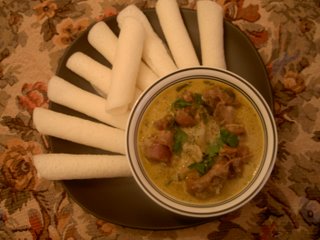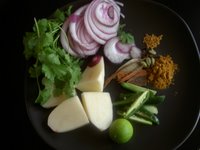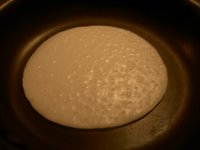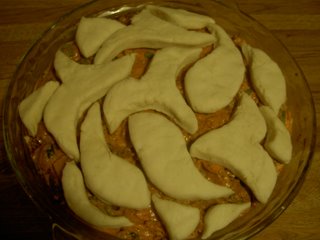
Mutton Stew /Mutton ishtu
Aroma of fresh herbs and whole spices, tanginess of lime, mellow sweetness of coconut milk: this stew combines amazing flavors into one tantalizing dish. No more words, dive into a world of goodness.
Mutton pieces, with bones : 2 lb
Coconut Milk: 1 cup
Green chilli : 3-4 medium sized 
Onion , sliced: a quarter
Ginger paste: 1 t
Garlic paste: 1t
Potato, cut into large pieces : 1
Cilantro, chopped: 1 cup
Mint, chopped: ¼ cup
Cinnamon : 3 to 4small sticks
Cardamom: 3-4
Clove: 3
Fenugreek: ¼ t
Corriander powder (roasted): 1t
Lime: 1
Hot water: 2 to 3 cups
Oil: 2T
Salt
Heat oil in a pressure cooker: add fenugreek seeds and fry for a minute.
Now cinnamon, cardamom and cloves to the hot oil, and fry till their aroma seeps out.
Throw in the onions, ginger-garlic, green chilies, coriander powder, mint leaves and half of the cilantro. Stir,stir,stir for two minutes so that the coriander powder doesn’t stick to the bottom. A lovely aroma should hit your nostrils now, reminding you to Thank Someone for such small pleasures in life.
Add potato and mutton and cook them in the mixture for three to four minutes. Now pour hot water, add enough salt, cover the cooker and let cook till it gives two whistles. You may whistle along with the cooker, if you please. Turn down the heat to low and cook for a good 45 minutes to 1 hour. This slow cooking under pressure gets the meat to a soft, buttery texture that goes so well with the coconut milk in this curry. Turn off the heat, let the cooker cool down and open the lid. Pour the coconut milk, and bring to a quick boil. Remove from heat, add rest of the cilantro, and lime juice and your stew is ready to be sapped up. Thank God for such pleasures!

Rice roti / Ari pathiri
As I have mentioned earlier, Keralites have gazillion ways of eating rice. Pathiri, though mostly made out of rice, can be compared to the roti of north Indian cuisine. There is a delightful variety of pathiris, some plain, some stuffed, and some layered and steamed. This recipe is for the basic pathiri with variant names like aripathiri /ari aracha pathiri/ arichu chutta pathiri / thadicha pathiri .Traditionally, soaked rice is stone ground into a thick buttery paste , and pathiris are shaped out of this dough with hands directly onto the hot pan. An art, nothing less. With no stone grinder here, we simply make a fairly thick batter in our meek food processer, and pour it out into the pan. A poor substitute, you say? The pathiris turn out to be pretty good though, and would almost pass out as the authentic one. Almost, stresses the dissatisfied pathiri connoisseur in me;)
The trick in getting these pathiris real soft is in the rice you use and in soaking it in boiling water. I stick to Ponni rice, since that is what my mother and her mother and so on have been using to make perfect pathiris. Dipping hot pathiris one by one as they come from the pan in coconut milk is a grand touch to this dish, adding a mellow taste to them. I did not follow it as the curry is a coconut milk based one, and the fat content on the can’s nutrition label always stirs up a fear somewhere.
Okay stop talking, just give me the recipe:
Ponni parboiledRice, washed, drained : 2 cups
Salt
Bring a large pot of water to rolling boil, and take the pot off heat.
Add the washed rice , cover and keep aside for 45 minutes. After this hot water soaking the rice should look like cooked on the outside, but should have a bite to it.
Drain excess water. Add salt and blend the rice into a smooth paste  adding a little, about ½ to 1 cup of water. Try adding the water little by little , so that you can get your blender going using as little water as possible.
adding a little, about ½ to 1 cup of water. Try adding the water little by little , so that you can get your blender going using as little water as possible.
Heat a thick pan. Pour a ladle full of batter, and let it spread out on its own into a thick circle. Cover and cook for 2 to 3 minutes. Turn over and cook fo r another two minutes. Once this side is fairly cooked, gently press on the rotis with a spatula so that little bubbles rise up, turn over the roti again and repeat the process on this side too. This is to make sure the pathiris thoroughly cooked inside. Your pathiri is done. Tear a piece gently, dip into your stew and enjoy bliss.
r another two minutes. Once this side is fairly cooked, gently press on the rotis with a spatula so that little bubbles rise up, turn over the roti again and repeat the process on this side too. This is to make sure the pathiris thoroughly cooked inside. Your pathiri is done. Tear a piece gently, dip into your stew and enjoy bliss.
 A ball of rice with cabbage, now another with split mung dal and then a big ball with carrots and beans
A ball of rice with cabbage, now another with split mung dal and then a big ball with carrots and beans





